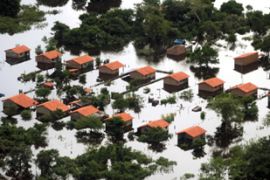Politics affects Bolivia aid effort
Water receding but about 40 per cent of the Beni district is still under water.

It also triggered an outbreak of dengue fever; a total of 1,950 cases confirmed or suspected so far.
Ernesto Suarez, Beni governor, said losses in his region total $115m.
Morales has visited Beni twice without greeting local authorities, going straight to poor, mostly indigenous, communities totally underwater on the outskirts of Trinidad.
Antonio Molpeceres, chief of the UN mission in Bolivia, flew over Beni on the weekend, viewing a flooded area twice the size of Switzerland, and promised urgent and co-ordinated international aid for rebuilding.
No co-ordination
| “The worst is over and now the hard part begins”
Jose Carlos Dellien, Beni regional emergency chief |
Suarez told Molpeceres his office has not co-ordinated with Morales’ government to distribute aid.
Suarez is one of a new generation of regional leaders who were elected for the first time in 2005; previously, regional governors were appointed by the president.
Most of these elected governors belong to opposition parties and want more autonomy for their provinces.
In an interview with Reuters last week, Suarez admitted the power struggle between his government and the Morales administration has hurt relief efforts in the Beni region.
He claims Morales took too long to recognise Beni as a disaster zone because the declaration could put his controversial plan to redistribute land to poor peasants on hold.
Morales’ land reform plan, which calls for the redistribution of almost a fifth of Bolivia‘s territory, is opposed by Beni’s cattle ranchers and large landowners in the eastern Santa Cruz district.
Poor affected
These differences in approach have been obvious to those receiving the donated supplies.
Aid from Spain given to the local government was distributed in sacks that said “Beni Department”, while the central government co-ordinated other deliveries with logistics aid from Argentina and Venezuela, which donated helicopters to the effort.
Teresa Arteaga, one of thousands of mothers with children taking refuge in Trinidad‘s schools, said: “They shouldn’t be fighting over who looks like they are giving the aid.